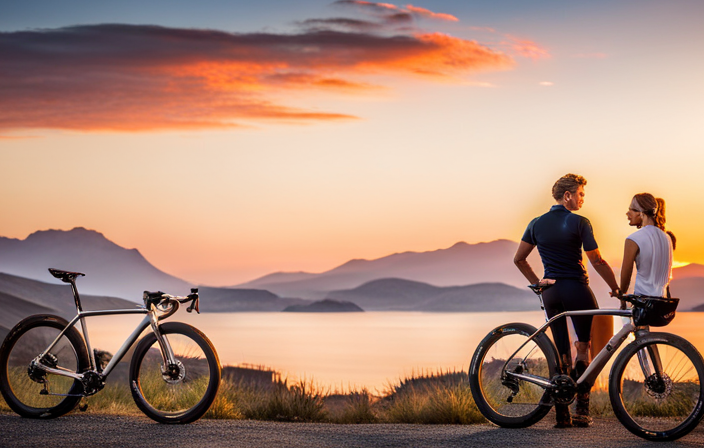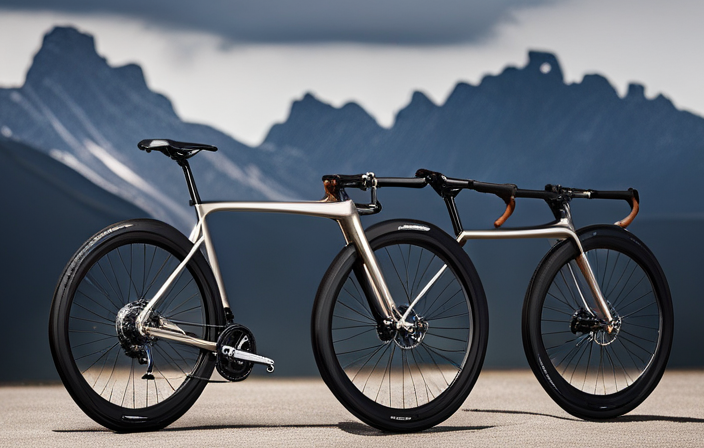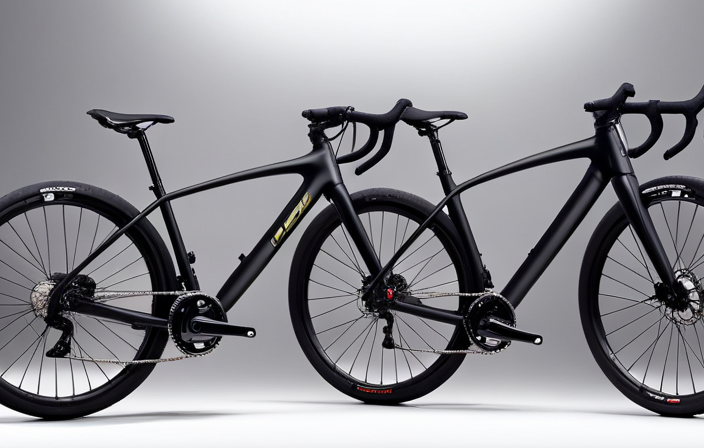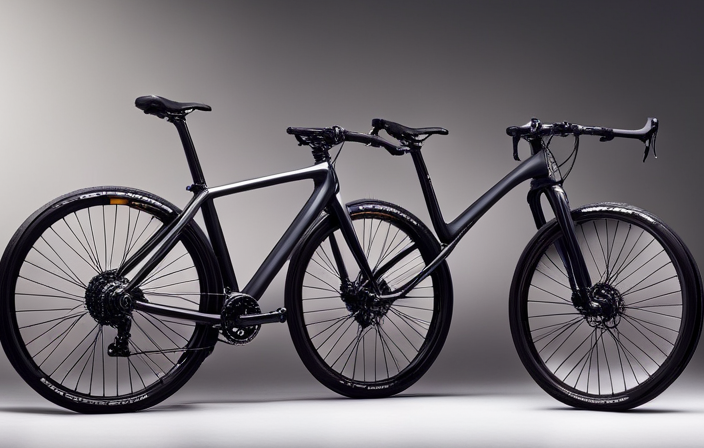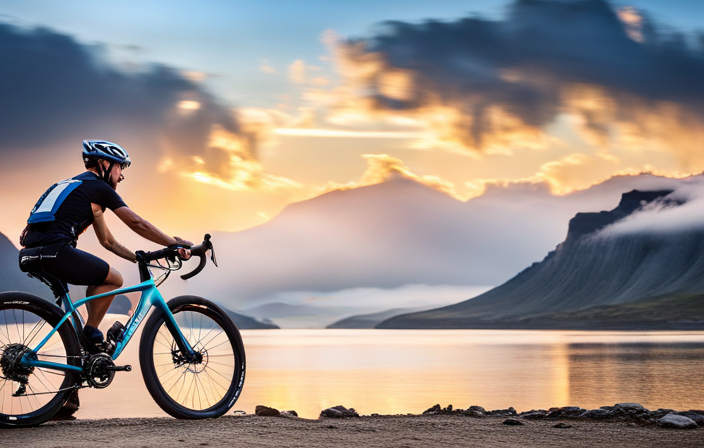Imagine this: you’re riding along a twisting gravel path, experiencing the thrill of adventure and liberation on your reliable gravel bike.
But suddenly, your tires lose traction, causing you to skid and struggle to maintain control. Don’t let this scenario become your reality!
In this article, I’ll guide you through the world of gravel bike tires and help you understand what kind of tires you need for different terrains and riding styles.
From tire size and width to tread patterns and durability, we’ll dive into all the technical details to ensure your next gravel ride is smooth and exhilarating.
Key Takeaways
- Tread pattern affects tire performance on different terrains
- Wider tire width improves stability and comfort on rough terrain
- Lower tire pressure increases grip on loose surfaces
- Consider riding style and terrain when selecting tires
Understanding the Basics of Gravel Bike Tires
You’ll need to understand the basics of gravel bike tires in order to make the right selection for your ride. When it comes to gravel biking, tire choice is crucial as it directly affects your performance on different terrains. There are several factors that can influence tire performance, and it’s important to consider them when making your decision.
One of the key factors affecting gravel bike tire performance is tread pattern. Gravel tires typically have a more aggressive tread compared to road bike tires, with larger knobs or blocks. This helps provide better traction and grip on loose surfaces such as gravel or dirt roads. Additionally, a wider tire width can also contribute to improved stability and comfort on rough terrain.
Another factor to consider is tire pressure. Lowering the pressure allows for increased contact area between the tire and the ground, enhancing grip on loose surfaces. However, running too low pressure can increase the risk of flats or burping air from tubeless setups.
When selecting gravel bike tires, you should also consider your riding style and terrain. If you enjoy fast-paced rides on smoother surfaces, a narrower and smoother tread pattern might be suitable. On the other hand, if you prefer tackling more technical trails or rougher terrain, opting for wider tires with more aggressive treads would be beneficial.
Understanding these basics will help you make an informed decision when choosing gravel bike tires that suit your riding style and preferred terrain without sacrificing performance.
Consider Your Riding Style and Terrain
If you ride aggressively on rough terrain, opt for tires that can handle the demands of your style. Your riding techniques and bike handling skills play a crucial role in determining the type of tires you need for your gravel bike. Here are four factors to consider when choosing tires:
-
Tread Pattern: Look for tires with aggressive tread patterns that provide excellent traction on loose surfaces like gravel and dirt. The deeper and more widely spaced knobs will ensure better grip while cornering or climbing.
-
Tire Width: Wider tires offer increased stability and comfort on rough terrain. Consider going for wider options, such as 40mm or more, as they provide a larger contact patch and improved floatation over loose surfaces.
-
Sidewall Protection: Opt for tires with reinforced sidewalls to prevent punctures from sharp rocks or thorns frequently found on gravel roads. This added protection will give you peace of mind during your rides.
-
Tubeless Ready: Consider using tubeless tires as they allow you to run lower pressures without the risk of pinch flats. This enhances traction, reduces rolling resistance, and provides a smoother ride over uneven surfaces.
When considering tire selection for your gravel bike, it’s essential to keep these factors in mind to optimize performance based on your riding style and the terrain you encounter regularly.
Now let’s dive into the next section about ‘gravel bike tire size and width’ to understand how these factors affect overall performance without any interruption in our discussion about tire choices.
Gravel Bike Tire Size and Width
Consider the size and width of your tires to ensure optimal performance on gravel roads. When it comes to gravel bike tire pressure, choosing the right tire width is crucial. The width of your tires affects traction, stability, and comfort on different types of terrain.
For gravel riding, wider tires are generally preferred. They provide better grip and control when navigating loose surfaces like gravel or dirt. A tire width between 35mm and 45mm is commonly recommended for gravel bikes. This range strikes a balance between speed and stability, allowing you to tackle various terrains with confidence.
The ideal tire pressure for your gravel bike will depend on factors such as rider weight, terrain conditions, and personal preference. Generally speaking, lower tire pressures are favored for off-road riding as they increase traction and absorb bumps more effectively. However, too low of a pressure can result in pinch flats or reduced efficiency on smoother surfaces.
Transitioning into the next section about tubeless vs. tubed tires: Now that we’ve considered the importance of tire size and width for optimal performance on gravel roads, let’s explore another aspect to consider: whether to go tubeless or stick with traditional tubed tires.
Tubeless vs. Tubed Tires
When deciding between tubeless or tubed tires, it’s important to understand the pros and cons of each option. Here is a comparison between tubeless and tubed tire performance:
-
Tubeless Tires:
- Pros: Tubeless tires offer better puncture resistance as the sealant inside can quickly seal small holes. They also provide a smoother ride due to lower tire pressure.
- Cons: Installing and maintaining tubeless tires can be more complicated than traditional tubed tires. Additionally, they may require more frequent topping up of sealant.
-
Tubed Tires:
- Pros: Tubed tires are easier to install and maintain, making them more convenient for riders who prefer simplicity. They are also less expensive compared to tubeless options.
- Cons: Tubed tires are more prone to flats as the inner tubes can pinch or get punctured easily. They might require higher tire pressure which leads to a harsher ride.
Considering these factors, it ultimately comes down to personal preference and riding style. If you prioritize convenience and cost-effectiveness, tubed tires may be your best bet. However, if you value puncture resistance and a smoother ride, then tubeless tires could be the right choice for you.
Now let’s transition into discussing tread patterns for different conditions without missing a beat.
Tread Patterns for Different Conditions
Now let’s explore the importance of tread patterns in various riding conditions.
When it comes to gravel bike tire tread patterns, choosing the right one can greatly enhance your riding experience. Tread patterns play a crucial role in providing traction and control, especially on loose gravel surfaces.
For loose gravel, you’ll want a tire with aggressive knobs or lugs that can dig into the terrain and provide grip. These larger knobs help to prevent slippage and ensure stability as you navigate through challenging gravel roads. Additionally, wider spaced knobs allow mud and debris to be easily shed from the tire, preventing buildup that could hinder performance.
On the other hand, if you’re mostly riding on hard-packed or smoother gravel surfaces, a tire with smaller and more tightly packed knobs will suffice. This type of tread pattern provides lower rolling resistance while still maintaining sufficient grip for these conditions.
Transitioning into the subsequent section about puncture protection and durability, it is important to note that tread pattern alone does not determine a tire’s ability to resist punctures or its overall durability. Therefore, considering both tread pattern and other factors such as casing thickness and puncture protection layers is essential when selecting tires for your gravel bike.
Puncture Protection and Durability
To ensure your ride is smooth and worry-free, it’s important to prioritize puncture protection and durability when choosing the right tread pattern for your gravel bike. Here are four key factors to consider:
-
Reinforced Sidewalls: Look for tires with reinforced sidewalls that can withstand the rough terrain of gravel riding. These sidewalls provide extra protection against cuts and abrasions, reducing the risk of punctures.
-
Thick Tread: Opt for tires with a thick tread as they offer better puncture resistance compared to thinner treads. The thicker the tread, the less likely sharp objects will penetrate through and cause flats.
-
Puncture Protection Layers: Some tires feature additional layers of material beneath the tread, such as Kevlar or nylon, which act as barriers against punctures from thorns, rocks, or glass shards.
-
Long Lifespan: Consider tire lifespan when evaluating options. High-quality tires often come with longer durability due to their superior construction materials and design.
By ensuring your gravel bike has adequate puncture protection and durability features in its tire choice, you can minimize unexpected mishaps on your rides while enjoying peace of mind knowing that your tires can handle challenging terrains without compromising performance.
Moving forward into our discussion on rolling resistance and speed…
Rolling Resistance and Speed
Rolling resistance and speed are important factors to consider when selecting the right tread pattern for your gravel bike. The tread design of a tire can significantly impact its rolling resistance, which directly affects how fast you can go on different surfaces. Generally, tires with a smoother center tread and smaller knobs have lower rolling resistance, allowing you to maintain higher speeds on gravel roads. However, it’s essential to strike a balance between low rolling resistance and sufficient traction.
When it comes to rolling resistance, tire pressure plays a crucial role as well. Higher tire pressures tend to reduce rolling resistance by minimizing the amount of tire deformation on rough surfaces. However, excessively high pressures can result in reduced grip and handling. Therefore, finding the optimal tire pressure for your specific riding conditions is essential.
In addition to rolling resistance and tire pressure, considering the overall tread pattern is important for handling on gravel terrain. Tires with larger knobs provide better traction and control in loose or muddy conditions but may sacrifice some speed on harder-packed surfaces.
Transitioning into the next section about ‘tire pressure and grip,’ it’s important to understand how these factors work together to determine your overall performance off-road without compromising safety.
Tire Pressure and Grip
Finding the right tire pressure is crucial for maintaining grip and control while riding off-road. When it comes to gravel biking, tire pressure can greatly affect your ability to handle different terrains. Adjusting the tire pressure allows you to adapt to various conditions and optimize your performance.
To start, choosing the right tire width is important. Wider tires provide more stability and better traction on loose surfaces like gravel or dirt. However, they also increase rolling resistance on smoother surfaces. On the other hand, narrower tires reduce rolling resistance but may compromise grip on rougher terrain.
Once you have selected the appropriate tire width, adjusting the tire pressure becomes essential. Lowering the pressure increases traction by allowing more of the tire’s surface area to make contact with the ground. This helps prevent slipping and sliding when navigating through loose gravel or uneven trails.
However, it’s important not to go too low with your tire pressure as this can lead to pinch flats or bottoming out on sharp rocks or roots. It’s a delicate balance that requires some trial and error to find what works best for you and your bike.
In conclusion, finding the right combination of tire width and pressure is key for optimal grip and control when riding off-road. Now let’s explore specialized tires for wet and muddy conditions…
Specialized Tires for Wet and Muddy Conditions
If you’re riding in wet and muddy conditions, you’ll want to consider specialized tires for better traction and control. When it comes to wet weather performance, tire tread design plays a crucial role. These specialized tires are specifically designed to excel in slippery conditions, providing enhanced grip on wet surfaces.
One key feature of these tires is their deep and aggressive tread pattern. This helps to channel water away from the contact patch, allowing the tire to maintain better traction on wet roads or muddy trails. The wider spacing between the knobs also prevents mud from clogging up the tire, ensuring consistent performance even in extremely muddy conditions.
Another important aspect is the rubber compound used in these tires. They are formulated with softer compounds that offer improved grip on wet surfaces without compromising durability. This allows riders to confidently tackle slick terrains while maintaining control over their bike.
In addition, some specialized tires have additional features like reinforced sidewalls for added stability and puncture resistance when navigating through challenging terrain.
Transitioning into all-round versatile tires for various terrains, there are options available that combine elements of both wet weather performance and general versatility. These tires strike a balance between grip on slippery surfaces and low rolling resistance on dry roads or hard-packed gravel paths.
All-Round Versatile Tires for Various Terrains
When it comes to tackling different terrains, there are versatile tires available that combine wet weather performance with general versatility. These all-round tires are perfect for gravel biking enthusiasts like myself who want to explore various terrains without compromising on performance. One important aspect to consider when choosing tires for a gravel bike is tire pressure variations. Adjusting the tire pressure can greatly impact the ride experience and comfort on different surfaces. Lowering the tire pressure provides better traction and shock absorption on rough terrain, while higher pressures increase efficiency on smoother surfaces.
To give you an idea of the options available, here’s a table showcasing some popular all-round gravel bike tires:
| Brand | Model | Width (mm) | Terrain Suitability |
|---|---|---|---|
| Schwalbe | G-One Allround | 40 | Mixed surface |
| Panaracer | GravelKing SK | 43 | Gravel, dirt roads |
| WTB | Riddler | 45 | Loose gravel, hardpack dirt |
Wider gravel bike tires have become increasingly popular among riders due to their numerous benefits. They provide better stability and control in challenging conditions such as loose gravel or muddy trails. Additionally, wider tires offer increased grip and improved flotation over softer surfaces. This not only enhances overall safety but also allows riders to confidently tackle more technical sections of a trail.
As we transition into the next section about lightweight and fast-rolling tires for racing, it’s important to note that finding the right balance between width and weight is crucial for optimal performance in competitive environments where speed is key.
Lightweight and Fast-Rolling Tires for Racing
Transitioning to lightweight and fast-rolling tires can significantly enhance speed and performance in racing. When it comes to racing on a gravel bike, having the right tires can make all the difference.
Ultralight gravel bike tires are designed specifically for racing, offering reduced weight and increased speed. These tires are made with high-quality materials that prioritize weight reduction without compromising durability.
One important consideration when choosing lightweight gravel bike tires is whether to opt for tubeless or clincher tires. Tubeless tires have gained popularity in recent years due to their ability to provide better puncture resistance, lower rolling resistance, and improved traction compared to traditional clincher tires. Additionally, tubeless setups allow you to run lower tire pressures for enhanced comfort and grip.
The advantages of lightweight and fast-rolling tires go beyond just speed. They also contribute to improved handling and maneuverability on challenging terrain, allowing riders to navigate corners with precision and confidence during races.
As we transition into the subsequent section about durable and puncture-resistant tires for long-distance adventures, it’s important to remember that finding the perfect balance between weight savings and reliability is crucial when selecting your gravel bike tires.
Durable and Puncture-Resistant Tires for Long-Distance Adventures
Opting for puncture-resistant tires on long-distance adventures can ensure durability and reliability throughout the journey. When embarking on lengthy rides, it is crucial to equip your gravel bike with tires that can withstand the challenges of rugged terrains without compromising performance.
Advances in tire technology have paved the way for innovative solutions from some of the best tire brands in the industry. These brands have developed durable and puncture-resistant tires specifically designed for long-distance adventures.
-
Schwalbe: Renowned for their Marathon line, Schwalbe offers tires that combine low rolling resistance with exceptional durability, making them ideal for extended rides on gravel roads.
-
Continental: With their Gatorskin and Hardshell models, Continental provides riders with excellent protection against punctures without sacrificing speed or comfort.
-
Maxxis: Maxxis has gained recognition among gravel enthusiasts by offering a range of tubeless-ready options such as their Rambler and Refuse models, known for their durability and grip.
These tire technology advancements allow riders to confidently tackle challenging surfaces while minimizing the risk of flats. As you transition into considering budget-friendly tire options, it’s important to remember that quality and reliability should not be compromised.
Budget-Friendly Tire Options
To save money on your tire purchase, consider exploring budget-friendly options that still offer reliability and performance for your long-distance adventures. Affordable tire options can be a great choice for gravel biking enthusiasts who want to get the most out of their rides without breaking the bank.
When looking for these affordable options, it’s important to prioritize longevity and performance.
One budget-friendly tire option that I highly recommend is the Continental Contact Plus. These tires are known for their durability and puncture resistance, making them ideal for long-distance adventures on gravel roads. They feature a robust construction with a thick layer of rubber that provides excellent protection against flats and cuts. Additionally, their low rolling resistance ensures a smooth and efficient ride.
Another affordable option worth considering is the Schwalbe Marathon Mondial. These tires are designed to handle various terrains, including gravel paths, with ease. They offer exceptional grip and traction while maintaining good puncture resistance. The Marathon Mondial also has a high-quality compound that provides excellent longevity, allowing you to enjoy many miles of riding without worrying about replacing your tires frequently.
When it comes to finding budget-friendly tire options for your gravel bike, don’t compromise on longevity and performance. Look for reliable brands like Continental or Schwalbe that offer affordable choices without sacrificing quality. By choosing these affordable yet reliable tires, you can confidently embark on your long-distance adventures without breaking the bank.
Now let’s transition into discussing maintenance and care for your gravel bike tires.
Maintenance and Care for Gravel Bike Tires
Taking proper care of your gravel bike tires is essential for maintaining their longevity and performance. Proper bike tire maintenance not only helps prevent tire damage but also ensures a smooth and safe ride on various terrains. Here are some tips to help you keep your gravel bike tires in top shape.
Firstly, regularly check the tire pressure to ensure it is within the recommended range. Underinflated tires can increase the risk of pinch flats and sidewall damage, while overinflated tires may result in reduced traction and a harsher ride. Additionally, inspect the tread for any signs of wear or cuts that could compromise grip and stability.
Cleaning your tires after each ride is also crucial. Use a mild soap and water solution to remove dirt, debris, and any potential contaminants that may cause premature wear or damage. Avoid using harsh chemicals or solvents as they can degrade the rubber compound.
Furthermore, it’s important to store your gravel bike properly when not in use. Keep it in a cool, dry place away from direct sunlight or extreme temperatures that can accelerate tire degradation.
By following these maintenance practices, you can significantly extend the lifespan of your gravel bike tires and maximize their performance on every ride.
Now let’s move on to recommendations for top gravel bike tire brands without skipping a beat!
Recommendations for Top Gravel Bike Tire Brands
Make sure you check out the top brands for your gravel bike tire recommendations!
When it comes to finding the perfect tires for your gravel bike, there are a few factors to consider. First and foremost, you’ll want to look at the top gravel bike tire models on the market. Some popular options include the Schwalbe G-One Allround, Panaracer GravelKing SK, and Maxxis Rambler. These tires are known for their durability, versatility, and excellent grip on various terrains.
When choosing gravel bike tires, it’s important to think about the type of riding you’ll be doing. If you plan on tackling rougher terrain with loose gravel or dirt roads, a wider tire with more aggressive tread patterns would be beneficial. On the other hand, if you’ll mainly be riding on smoother surfaces or paved roads, a narrower tire with less aggressive tread can provide a faster and smoother ride.
Other factors to consider include puncture protection and rolling resistance. Look for tires that offer good puncture protection features like reinforced casing or added layers of rubber. Additionally, consider how much rolling resistance you’re willing to tolerate – some tires prioritize speed while sacrificing grip and vice versa.
By considering these factors and exploring the top brands in the market, you can find the perfect gravel bike tires that suit your riding style and preferences. Happy riding!
Frequently Asked Questions
Are there any specific recommendations for gravel bike tires that are suitable for winter riding conditions?
For winter riding conditions on a gravel bike, I recommend tires with aggressive tread patterns. These patterns have larger knobs and deeper grooves to provide better traction on slippery surfaces like snow and ice.
Look for tires specifically designed for winter or mixed conditions, as they often have special rubber compounds that remain grippy even in cold temperatures.
Additionally, consider wider tires for increased stability and floatation in snowy or loose terrain.
What are the advantages and disadvantages of using tubeless tires for gravel biking?
When it comes to gravel biking, using tubeless tires has its pros and cons.
The advantages are numerous: reduced risk of flats due to the absence of tubes, lower rolling resistance for a smoother ride, and the ability to run at lower tire pressures for enhanced traction on rough terrain.
However, there are also some drawbacks to consider. Tubeless setups can be more challenging to install and maintain, requiring sealant and periodic checks for leaks. Additionally, they may be more expensive upfront compared to traditional clincher tires.
Can I use the same tires for both road cycling and gravel riding?
Yes, you can use slick tires for gravel riding, but they may not provide the best traction on loose or uneven surfaces. It is recommended to use wider tires with a tread pattern that offers more grip and stability for gravel biking.
As for tire pressure, it depends on various factors such as rider weight and terrain conditions. Generally, lower tire pressures around 35-40 psi are suitable for better control and comfort on gravel trails.
How do I choose the right tire width for my gravel bike?
Choosing the right tire width for a gravel bike is crucial as it directly impacts performance on different terrains. Factors to consider include terrain type, rider weight, and desired level of comfort.
For example, wider tires (around 40-45mm) provide better traction and stability on loose gravel or muddy surfaces. However, they may compromise speed on smoother roads.
Narrower tires (around 30-35mm) are suitable for riders prioritizing speed on hard-packed gravel or pavement but may lack grip in challenging conditions.
Are there any specific tire brands that are known for their durability and puncture resistance?
When it comes to tire brands with good traction and the best options for off-road riding, there are a few that stand out.
Continental’s Cross King and Terra Speed tires offer excellent durability and puncture resistance, thanks to their reinforced sidewalls and advanced rubber compounds.
Schwalbe’s G-One Allround and WTB’s Riddler tires also provide impressive grip and protection on gravel terrain.
These brands have proven track records in delivering high-quality tires for adventurous riders seeking optimal performance on rough terrains.
Conclusion
After carefully considering my riding style, terrain, and the various options available, I have come to the conclusion that choosing the right tires for my gravel bike is crucial.
The size and width of the tires should be tailored to suit my specific needs, while tread patterns should be selected based on the conditions I will encounter.
Additionally, opting for durable and puncture-resistant tires will ensure a smooth and hassle-free long-distance adventure. With budget-friendly options also available, taking care of my gravel bike tires is essential for optimal performance.
Remember, choosing top gravel bike tire brands guarantees quality and reliability. So go ahead and hit those gravel trails with confidence!
